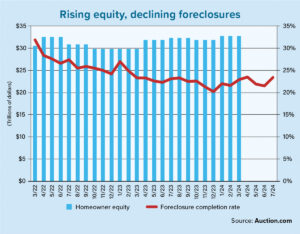There’s a growing appeal for fixer-upper properties. Inspired by popular television series and other media, potential homebuyers are gaining confidence in their ability to find lower-priced homes that they can transform into their dream home. That’s why renovation loans are becoming increasingly popular.
Contractors are lining up to keep pace with real estate trends. The largest increase in the number of new businesses between 2012 and 2017 was in the construction sector, according to the U.S. Census Bureau. Over that time period, 116,874 new construction companies were formed, an increase of 19.5%.
There are a number of reasons behind the demand for renovation mortgages. In many geographic areas, homebuyers are faced with a shortage of inventory. The National Association of Realtors reported that home prices increased in 91% of U.S. metro areas in second-quarter 2019. For many, an affordable home might be one that needs work.
First-time homebuyers are not alone in dealing with rising housing costs. Those who purchased smaller starter homes are now looking to add more space, in lieu of paying a high price for a larger “move-up” home. This represents a whole new market of consumers looking to finance property-expansion projects.
For originators looking to help these clients, the first step is to determine whether the appropriate loan program is a construction loan or a renovation mortgage.
For originators looking to help these clients, the first step is to determine whether the appropriate loan program is a construction loan or a renovation mortgage. There is a fine line between these two types of financing. Ironically, these lines might be the support beams throughout the house.
If renovation plans involve the removal of exterior walls, the roof and certain interior support structures, the project may be considered a teardown. Sometimes, fixer-upper properties have missing portions of the roof, outside walls, or windows and entrances to the home or basement, exposing the house to intrusion and storm damage. The extent of exposure will ultimately determine whether the appropriate financing is renovation or construction.
Constructions loans
A construction loan is short-term financing and also is known as interim financing. Construction loans are generally associated with custom-built homes situated on a privately owned parcel of land. Typically, homebuyers will hire a licensed contractor, who installs the foundation and builds the home in accordance with an architectural plan. In the mortgage industry, these properties are called site-built homes.
Builders must provide the homebuyer with an initial cost estimate to submit to their lender. Once borrowers are preapproved for construction financing, the lender will likely request a signed contract from the builder, along with copies of their license, insurance certificate, construction plans and specifications. Contracts generally outline the detailed cost for the foundation, completed exterior structure, electrical, plumbing, interior finishing, heating, cooling, roof and windows.
The mortgage lender will disburse funds to the builder on a structured basis as certain phases are completed. Usually, 20% of the total loan is advanced to build the foundation. During the construction period, the lender will complete site inspections to confirm each phase is completed before disbursing the next installment. When the home is completed, the town assessor’s office (or local jurisdiction) will issue a certificate of occupancy, which allows the homebuyers to take possession.
While the home is being built, most homebuyers will seek a permanent mortgage, sometimes called an end loan. A popular financing option is known as a construction-to-permanent mortgage. These loans also are known as singleclose loans, since they eliminate the necessity for borrowers to apply for two types of financing. Construction-to-permanent mortgages can be used to finance the purchase of a modular or manufactured home, with the loan proceeds covering the cost of the building materials, construction of a foundation, and for the installation and finishing of the house.
Freddie Mac offers construction-conversion loans on newly built, one- to four-unit site-built homes, as well as newly purchased one-unit manufactured homes that have never been attached to a foundation. Programs are available for primary residences, as well as second-home or investment-property transactions. Fixed-rate or adjustable-rate mortgages are available for purchases and refinances. The construction-conversion loan provides a streamlined option for borrowers to obtain interim financing and build a new home on land that has been purchased separately. After all work is completed, the loan converts to a permanent mortgage.
Renovation loans
Renovation loans are over-the-top mortgages. In other words, the lender will approve a mortgage that covers both the as-is price of a home, plus the cost of improvements. After agreeing to an as-is price from the seller, borrowers can apply for a mortgage that covers both the renovation costs and purchase price.
“For less extensive work, the limited 203(k) program permits homebuyers and current homeowners to finance up to $35,000 for repairs, improvements or upgrades.”
Homebuyers must obtain a cost estimate from a professional contractor that describes all of the repairs or property improvements. The lender will hire a certified appraiser or another professional evaluator to determine the as-completed property value.
For example, a buyer has an opportunity to buy a home for $150,000 and has obtained an estimate for $50,000 worth of improvements. The lender will ask the property appraiser to review the estimate, and determine the ascompleted value based on the plans and specs. The lender will draw up a transaction in the amount of $200,000 and the maximum loan-to-value ratio is based on the projected as completed value.
At closing, the seller receives $150,000 and the lender will disburse the amount of money needed to cover the cost of materials. Remaining funds are held in escrow by the lender, who will disburse funds to the contractor on a structured basis, as work is completed. The appraiser’s final inspection will ultimately solidify the final loan-to-value ratio and transaction value.
DIY option
Fannie Mae offers a do-it-yourself (DIY) option in their HomeStyle renovation mortgage program, which allows borrowers to complete some of the renovations themselves. The DIY option is only available for renovations made on a single-family, owner-occupied home.
Under this program, borrowers may complete work covering an amount that is up to 10% of the as-completed property value. For example, if a home is purchased for $140,000 and the borrower obtains a contractor’s estimate for $60,000 worth of improvements, the transaction is structured for a home valued at $200,000.
This value must be supported by the appraiser after work is completed. Ten percent of that value (or $20,000), is work that can be completed by the borrower. The remaining $40,000 must be completed by a professional contractor. The lender must approve the DIY renovations in advance and inspections are required for any items that cost more than $5,000. This option is not available for manufactured homes.
Rehab mortgage
The Section 203(k) program is the primary program for the rehabilitation and repair of singlefamily properties through the Federal Housing Administration (FHA). This program is available to homebuyers who are able to finance both the acquisition and repair costs of their new home.
It also is available to homeowners who want to include renovation costs in the refinancing of their existing mortgage. The cost of the rehabilitation must be at least $5,000 and the total value of the property must fall within the FHA mortgage limit for that area. The value is determined by the current property value plus the renovation costs, or 110% of the appraised value of the property after rehabilitation, whichever is less.
Homes must be at least a year old, and the extent of the rehabilitation may range from minor to a full reconstruction. This includes a home that has been demolished, as long as the existing foundation remains in place. These loans may be used to finance a residential property that also has nonresidential uses.
The U.S. Department of Housing and Urban Development requires that properties financed under the 203(k) program meet certain basic energy-efficiency and structural standards.
Loans may be used to convert a property of any size into a one- to four-unit structure. The types of improvements that borrowers may make using Section 203(k) financing include reconstruction, modernization and elimination of health and safety hazards. It also can include such things as replacing plumbing, roofing, major landscaping, some energy-efficiency improvements or enhancing accessibility for disabled people.
Limited repair
For less extensive work, the limited 203(k) program permits homebuyers and current homeowners to finance up to $35,000 for repairs, improvements or upgrades. Unlike the standard 2 03(k) mortgage, there is no minimum repair cost.
Property repairs can include kitchen remodeling, carpeting or painting, or any items that were identified by a property appraiser or home inspector. Borrowers must submit a work plan to their lender and use one or more contractors to provide the cost estimate before completing the required improvements or repairs.
• • •
Contractors must be licensed and bonded, if required by the local jurisdiction. The limited 203(k) program allows a variety of improvements, including removing an in-ground pool, installing fencing, building a driveway or making a home accessible for those with disabilities.
Author
-

Anna DeSimone is author of "Housing Finance 2020: New Mortgage Programs for the New Generation of Homebuyers." DeSimone has written more than 40 published works on topics such as mortgage best practices, fair lending and regulatory compliance, including numerous guides published by the Mortgage Bankers Association. She is the former owner and founder of Bankers Advisory, a mortgage compliance and quality-control company. DeSimone was named one of HousingWire’s Women of Influence and has received numerous other awards.





